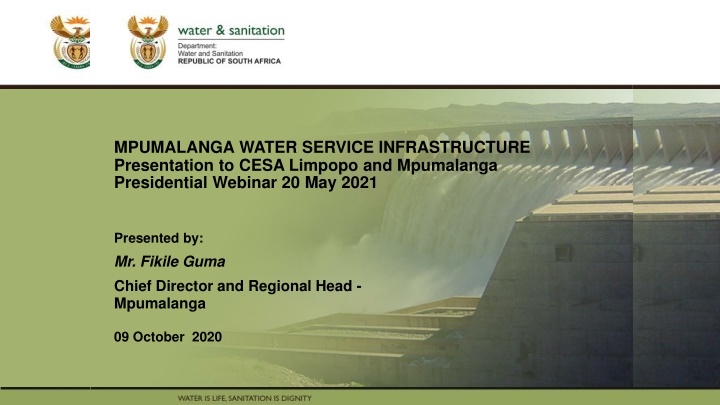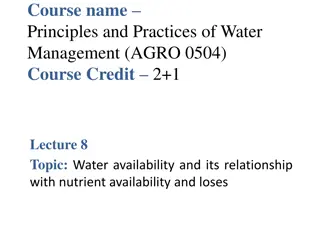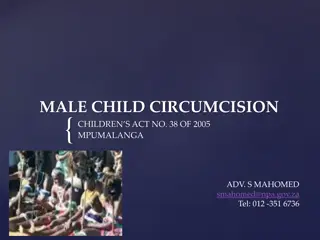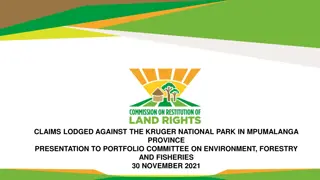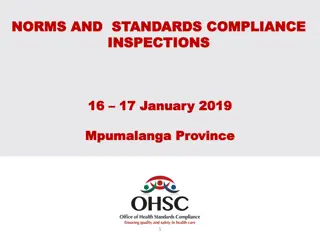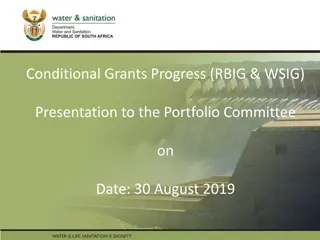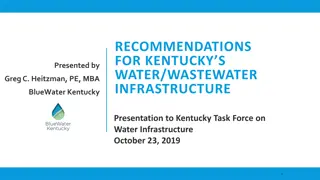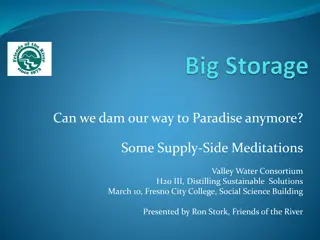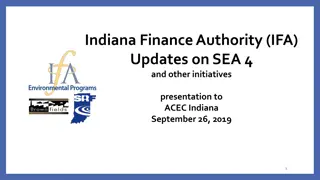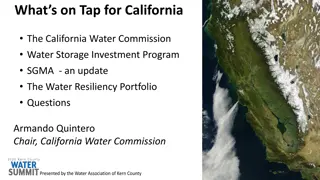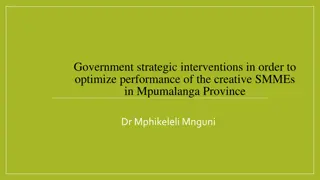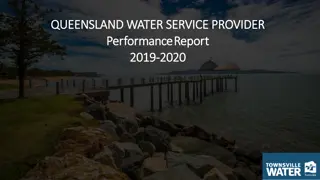Overview of Mpumalanga Water Service Infrastructure
Mpumalanga province in South Africa encompasses an area of 79,490 km2 and shares its boundaries with Mozambique, eSwatini, Lesotho, Namibia, and Botswana. The province has 26 main dams and water transfer schemes connecting it to other regions. There are three district municipalities and 17 local municipalities, all designated as Water Service Authorities. The presentation provides insights into the water resource infrastructure, large dams, and household access to water services in different districts.
Download Presentation

Please find below an Image/Link to download the presentation.
The content on the website is provided AS IS for your information and personal use only. It may not be sold, licensed, or shared on other websites without obtaining consent from the author.If you encounter any issues during the download, it is possible that the publisher has removed the file from their server.
You are allowed to download the files provided on this website for personal or commercial use, subject to the condition that they are used lawfully. All files are the property of their respective owners.
The content on the website is provided AS IS for your information and personal use only. It may not be sold, licensed, or shared on other websites without obtaining consent from the author.
E N D
Presentation Transcript
PRESENTATION TITLE MPUMALANGA WATER SERVICE INFRASTRUCTURE Presentation to CESA Limpopo and Mpumalanga Presidential Webinar 20 May 2021 Presented by: Name Surname Directorate Date Presented by: Mr. Fikile Guma Chief Director and Regional Head - Mpumalanga 09 October 2020
Provincial overview km2 Mpumalanga province encompasses an area of 79 490 The province is bordered by two African countries with are Mozambique and a Kingdom of eSwatini. All rivers are part of the internationally shared basins: Komati- Usuthu basin shared with Mozambique & a Kingdom of eSwatini. Vaal basin shared with Lesotho, Namibia & Botswana. Olifants-Limpopo basins shared with Zimbabwe, Mozambique & Botswana. The province has: three (3) District Municipalities (Gert Sibande, Ehlanzeni and Nkangala); and 17 Local Municipalities (LMs). All 17 LMs have been given status of being Water Service Authorities (WSAs). The estimated population in the province was at 4 300 000 (Stats SA: 2016) The estimated number of households was at 1 238 861 (Stats SA 2016) 2
MPUMALANGA MPUMALANGA CHARACTERISTICS OF WATER RESOURCE INFRASTRUCTURE CHARACTERISTICS OF WATER RESOURCE INFRASTRUCTURE There are 26 main Dams in the Province with a Storage Volume of just under 2.6 Billion m3. Groundwater use is limited in comparison to surface water The province s developed water resources are linked to those of other Provinces through transfer schemes Transfer schemes comprise Vaal, Olifants, and Usuthu linkages Other schemes to optimise the system are contemplated as Eskom needs and users in the Olifants Catchment change
Mpumalanga large dams Limpopo Blyderivierpoort Klasierie :Water transfers Injaka :Dams Ohrigstad Da Gama Mkhombo dam Witkip Klipkopie Longmere North West Mozambique Kwena Rust de Winter Primkop Loskop Driekoppies Middelburg Witbank Vygeboom Nooitgedacht Gauteng Westoe Trichardsfontein Swaziland Jericho Morgenstond Grootdraai Heyshope Vaal Free State Zaaihoek KwaZulu Natal 4
Water Services Provincial Perspective Households below basic level of service / backlogs as % Households below basic level of service / backlogs Households with Access to water as a % Total number of HH 2016 Households with Access to water Name of Municipality EHLANZENI DISTRICT 483 903 409 112 84.5% 74 791 15.5% NKANGALA DISTRICT 421 143 390 292 92.7% 30 851 7.3% GERT SIBANDE DISTRICT 333 815 305 282 91.5% 28 533 8.5% Grand Total PROVINCIAL 1 238 861 1 104 686 89.2% 134 175 10.8% 6
Sanitation Provincial Perspective SANITATION Household s with Access to Flush/Che mical toilets Households below basic level of service / backlogs as % Households with Access to sanitation as a % Households below basic level of service / backlogs Total number of HH 2016 Households with Access to VIP toilets Name of Municipality Households with Access to VIP as % EHLANZENI DISTRICT 483 903 139 885 28.9% 321 834 66.5% 22 184 4.1% NKANGALA DISTRICT 421 143 233 899 55.5% 180 173 42.8% 7 071 1.7% GERT SIBANDE DISTRICT 333 815 268 491 76.2% 57 859 17.3% 10 253 3.1% Grand Total PROVINCIAL 1 238 861 642 275 51.8% 559 866 45.2% 39 508 3.0% 7
Status: wastewater and water treatment works Mpumalanga Province consists of seventy seven (77) Municipal owned Wastewater Treatment Works (WWTWs) within their jurisdiction respectively. The Province is further serviced by fourteen (14) Wastewater Treatment Works owned by the Department of Public Works. They are ninety one (91) Municipal owned Water Treatment Works monitored by DWS. The Department conducts inspections on quarterly basis at Wastewater and Water Treatment Works (WWTWs) to ascertain compliance with the provision of the National Water Act, Act 36 of 1998; Water Services Act, Act 108 of 1997. 8
Municipal wastewater treatment works Mpumalanga 77 municipal WWTWs Gert Sibande DM (29) Nkangala DM (24) Ehlanzeni DM (24) 1. Dipaleseng LM: 4 WWTWs 2. Govan Mbeki LM: 6 WWTWs 3. Lekwa LM: 1 WWTWs & 1 Ponds system 4. Msukaligwa LM: 3 WWTWs & 3. Ponds systems 5. Mkhondo LM: 2 WWTWs 6. Chief Albert Luthuli: 1 WWTWs & 4 Ponds systems 7. Dr Pixley Ka Isaka Seme: 5 WWTWs 1. Thembisile Hani LM: 1 WWTWs & 3 Ponds systems 2. Dr JS Moroka LM: 1 WWTWs & 1 ponds system 3. Victor Khanye LM: 2 WWTWs 4. Emalahleni WWTWs: 8 WWTWs 5. Steve Tshwete LM: 4 WWTWs 6. Emakhazeni LM: 4 WWTWs 1. Bushbuckridge LM: 6 WWTWs & 1 Ponds system 2. Thaba Chweu LM: 4 WWTWs 3. City of Mbombela: 7 and 1 Pond system WWTWs 4. Nkomazi LM: 1 WWTWs and 4 Ponds Systems 9
Non-compliant wastewater treatment works Mpumalanga 34 municipal WWTWs Gert Sibande DM (12) Nkangala DM (10) Ehlanzeni DM (10) 1. Dipaleseng LM: 3 WWTWs 2. Govan Mbeki LM: 3 WWTWs 3. Lekwa LM: 1 WWTWs 4. Msukaligwa LM: 2 WWTWs 5. Dr Pixley Ka Isaka Seme: 3 WWTWs 1. Thembisile Hani LM: 1 WWTW & 1 Pond system 2. Victor Khanye LM: 2 WWTWs 4. Emalahleni WWTWs: 3 WWTWs 5. Emakhazeni LM: 3 WWTWs 1. Bushbuckridge LM: 3 WWTWs 2. Thaba Chweu LM: 3 WWTWs 3. Nkomazi LM: 1 WWTW and 1 Pond System 10
KEY ISSUES KEY ISSUES WATER SERVICES WATER SERVICES Lack of operational maintenance, no or low budget provision for equipment maintenance and repair. Vandalism especially of electrical equipment, cables and metal fittings. Non payment of Eskom and water boards resulting system being switched off or running at substantially lower output. Revenue management and billing not up to scratch. Shortage of qualified operational staff. Illegal connections to the system. Project disruptions by local business forums
